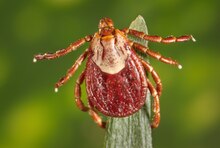| Dermacentor andersoni | |
|---|---|

| |
| Scientific classification | |
| Domain: | Eukaryota |
| Kingdom: | Animalia |
| Phylum: | Arthropoda |
| Subphylum: | Chelicerata |
| Class: | Arachnida |
| Order: | Ixodida |
| Family: | Ixodidae |
| Genus: | Dermacentor |
| Species: | D. andersoni
|
| Binomial name | |
| Dermacentor andersoni Stiles, 1908
| |

| |
Dermacentor andersoni, commonly known as the Rocky Mountain wood tick, is a hard tick, or member of the Ixodidae family, with three life stages including larvae, nymph, and finally adult, or, more entomologically, imago. This tick is generally located in the northwest United States and southwest Canada along the Rocky Mountains. This tick is generally a vector for Colorado tick fever, but can also be a vector for Rocky Mountain spotted fever and tularemia.[1] During the larval and nymphal stages, the tick does not feed on humans, but during the adult stage, it will. Prevention of infections associated with these ticks is based on control of exposure to the vector, including wearing proper clothing when in woods/wet areas, and checking oneself thoroughly after returning home. Adult female ticks can feed for 5 to 15 days, thus removing a tick if present is very important.[2] Follow general tick removal tips.
- ^ Lam, W. (2009). "Species Details Dermacentor andersoni". University of Alberta Museums. E.H. Strickland Entomological Museum. Retrieved November 8, 2020.
- ^ "Dermacentor andersoni". University of California, Davis. Archived from the original on June 3, 2013. Retrieved April 19, 2017.